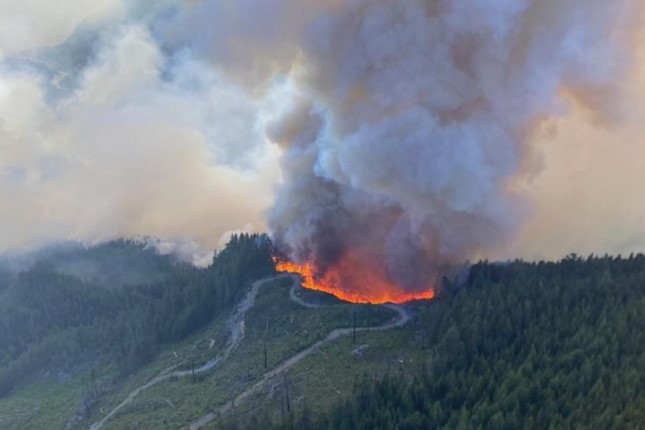The Canadian wildfires that started in May have brought severe impact to Canada and even the North American region. The latest data from the Canadian Interagency Forest Fire Centre shows that, as of Wednesday, a total of 4,774 fires have occurred nationwide in Canada, with cumulative burned areas of more than 121,000 square kilometers. This data has far exceeded the country's historical record of 76,000 square kilometers burned in 1989, surpassing the land area of South Korea, and is 7.5 times the cumulative disaster areas of wildfires in China from 2000 to 2021.
In addition to endangering the lives and property of local residents, the ecological damage and the emission of greenhouse gases caused by the wildfires have had an immeasurable impact on the human living environment. Recently, Chinese scientists used scientific methods to assess it and concluded that, as of Wednesday, the carbon dioxide emissions from Canadian wildfires have reached approximately 1 billion tons. Chinese scientists involved in this research told the Global Times that this astonishing data indicates that the carbon dioxide, methane, and nitrous oxides emitted by Canadian wildfires have had an undeniable impact on global climate warming. This has already developed into a global environmental event, rather than just wildfires happening in Canada, the scientists warned.
"Remote sensing technology is an effective method currently used to estimate carbon emissions from large-scale wildfires. It can conduct rapid and accurate assessment of carbon emissions from wildfires." Liu Zhihua, a researcher at the Shenyang-based Institute of Applied Ecology, Chinese Academy of Sciences, who participated in this study, told the Global Times on Wednesday.
The scientists estimated that, as of Wednesday, the carbon dioxide emissions from Canadian wildfires had reached approximately 1 billion tons.
In addition, Chinese scientists have estimated through the emission factor method that the greenhouse effect of methane and nitrous oxide emitted from this wildfires is approximately equivalent to 110 million tons of carbon dioxide. Combined with the direct emission of 1 billion tons of carbon dioxide, the carbon dioxide emissions from Canadian wildfires is equivalent to about 1.11 billion tons. Liu believes that this figure is quite astonishing, as the carbon dioxide emissions related to fossil energy in Canada in 2021 were about 546 million tons, and the carbon dioxide equivalent emissions from this year's wildfires are nearly twice that amount. 1.11 billion tons of carbon dioxide have already exceeded Japan's total energy-related carbon dioxide emissions for the year 2021, according to Liu.
According to data from the Global Carbon Project, Japan's total energy-related carbon dioxide emissions in 2021 were 1.067 billion tons, ranking fifth globally.
However, the wildfire in Canada this time has surpassed that record. "Furthermore, there is a concerning situation where about one eighth of the wildfires in Canada occur in permafrost areas, which could potentially promote the release of methane stored in the permafrost," Liu said.
In addition to causing serious harm to the climate through greenhouse gas emissions, this year's wildfires in Canada has also released air pollutants such as PM2.5, PM10, organic aerosols, and black carbon. This will inevitably have an impact on the environment and harm human health.
"Up to now, this wildfire has had significant cross-border impacts on air quality four times, namely from May 17 to 26, June 6 to 19, June 23 to 30, and July 15 to 20.
During these four instances of cross-border transmission, the air quality in the US was significantly reduced, with particulate matter exceeding 50 micrograms per cubic meter, leading to flight cancellations, school closures, and severe disruptions to production and daily life.
Among them, the second transmission process resulted in the most severe pollution weather in New York City since 1960. The third transmission process caused Chicago's air quality index to exceed the standard by 5.6 times on June 27, which will inevitably pose significant risks to the respiratory systems of local residents," Liu explained.
What is more serious is that due to the westerly circulation and weather dynamics, the PM2.5 released from the Canadian wildfire has also been transported across long distances.
Wang Zhe, an associate researcher at the Institute of Atmospheric Physics of the CAS, who participated in this study, told Global Times on Wednesday that research shows that PM2.5 released from the wildfires reached the Scandinavian Peninsula in Europe on May 25, spread to Iceland and Greenland on June 8, and affected mainland Europe on June 26. The atmospheric transport process from June 27 to 30 contributed more than 5 micrograms per cubic meter of PM2.5 in Europe. This transport process even affected North Africa and Asia, impacting a large area in the western part of China, contributing approximately 1-2 micrograms per cubic meter to PM2.5 concentrations in the western region of China, according to Wang.
Wildfires in Canada are indeed a global environmental event, and their ultimate impact will certainly be much more severe than the current data suggests," Wang said.
He further stated that this research outcome is only a preliminary assessment, and a comprehensive evaluation of the wildfires will be conducted once they are over. This evaluation will include the impact of greenhouse gas emissions on climate, the impact of particle emissions on the environment, and the effects on human health.
"We are currently combining air pollution epidemiology to assess the impact of this wildfire on human health, because the particulate matter generated by the wildfire may be more harmful to the human body than traditional PM2.5. The impact could be 2 to 10 times greater, mainly because the small particles produced by the forest wildfires are more likely to enter our lungs and then enter our bloodstream. This not only affects the respiratory system but also the cardiovascular system. Therefore, we will also conduct a comprehensive assessment of the harm caused by this wildfire to the human body in the later stage," Wang noted.
Rapidly burning wildfires can cause extensive damage and death to vegetation, resulting in not only a loss of biodiversity but also the loss of habitat and food sources for animals. Additionally, wildfires can destroy the vegetation cover, leading to exposed soil surfaces and exacerbating the frequency of secondary disasters such as soil erosion, sediment runoff, and landslides.
Wang further pointed out that the recent Canadian wildfires may also have an impact on the frozen layers in the polar regions. For example, the emissions of organic aerosols and black carbon, if deposited on the surface of the Arctic sea ice, can cause rapid melting of the ice. Therefore, the impacts of this wildfire are very complex and a comprehensive assessment will be needed using more comprehensive Earth system models in the future.
In recent years, with the increasing impact of climate change and human activities, extreme forest fires have been occurring frequently all around the world.
For example, in 2019, the Amazon forest fires caused a burnt area of over 90,000 square kilometers in 10 months. In 2019-2020, the Australian bushfires led to a burnt area of 243,000 square kilometers in one year. In 2021, the wildfires in Russia resulted in a burnt area of 181,600 square kilometers.
The wildfire season in Canada usually lasts until October, and there is a possibility that the current wildfire will continue to spread. The academic community also believes that the scale of the disaster will further expand, surpassing the country's historical records.
For a long time, the Western academic community has considered fire disturbance a natural process that regulates forest ecosystems, benefiting the stability of ecosystem structure and function. However, Liu believes that in recent years, the frequent occurrence of large-scale wildfires has exceeded the range of natural variation and has evolved into a destructive disaster.
Frequent and severe wildfires not only rapidly deplete carbon reserves in vegetation and soil, but also alter the natural succession of forests, leading to ecosystem degradation into shrublands or grasslands, significantly reducing the carbon sequestration function of the ecosystem. Therefore, large-scale wildfires disrupt the balance of ecosystems, rather than being considered as traditional ecological disturbance processes, Liu explained.
"The forest protection concept in European and American countries first focuses on the protection of people's lives and property, and secondly on important natural resource areas. As to the fires in remote areas, they preferring monitoring rather than interfering in as they believe that everything will eventually return to its original state after one or two hundred years, considering it as a natural evolutionary process," Liu said.
However, Liu noted that extreme environmental events are occurring frequently nowadays, which has exceeded the scope of natural changes and has evolved into a destructive ecological disaster. At this time, proper human intervention is needed.
If the fires go straight up to the tree crowns and become strong, the effectiveness of human intervention may be limited. Currently, wildfires in Canada spread very quickly and release a lot of energy, so the effectiveness of human intervention is limited." Liu explained to the Global Times.
It is worth mentioning that the forest area in China is approximately 2.31 million square kilometers, which is roughly two-thirds of the forest area in Canada. The forest coverage rate is about 24.02 percent. Such extensive distribution of forests has brought significant challenges to our country's forest fire prevention work. However, over the years, China has accumulated rich experience in forest fire prevention and control, successfully reducing the occurrence rate and disaster losses of forest fires, and significantly improving the comprehensive capacity for fire prevention and control, Liu said.
According to estimation, the average annual emission of carbon dioxide caused by forest fires in China from 2000-2021 was approximately 15 million tons, only account for 0.2 percent of the global forest fire emissions, demonstrating China's responsible role as a major country, Liu said.
Photo: Undated aerial photo provided by BC Wildfire Service shows wildfires in the coastal region of British Columbia, Canada. Canada is seeing its worst fire season on record as hundreds of blazes rage across the country, with more than 250 burning "out of control," according to the Canadian Interagency Forest Fire Centre © BC Wildfire Service / Handout via Xinhua.
Source: The Global Times.
































